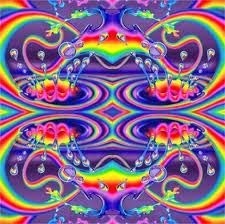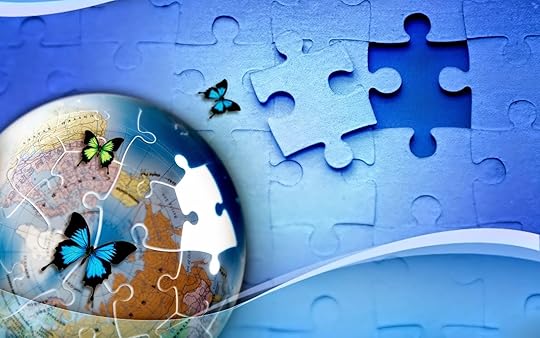Pearl Zhu's Blog, page 1447
March 18, 2015
Performance Management vs. Change Management
 The speed of change is accelerating, and organizations are also shifting from operation-centricity to customer centricity; from inside-out to outside-in .When quality and values in your market changes constantly, your measures of P (Performance) have to move with it, better than that, anticipate it and rearrange around coming tastes and preference changes.
The speed of change is accelerating, and organizations are also shifting from operation-centricity to customer centricity; from inside-out to outside-in .When quality and values in your market changes constantly, your measures of P (Performance) have to move with it, better than that, anticipate it and rearrange around coming tastes and preference changes.
Change Management is necessary and challenging when you diagnose the following symptoms, and perhaps measures are good starting point to change: Change becomes necessary when an organization fails to meet its performance goals, probably as a result of behaviour following a path of self-interest."Tell me how you will measure me and I'll tell you how I will behave." People's behaviour usually responds to how they are measured. Does this mean that you are applying the wrong measures at a personal and group level? Perhaps measures are a good place to start change, therefore, when starting the change process, in order to detect behaviour that is not congruent with group goals.The problem is actually more complex. Information systems have been built in the firm around those measures. Its systems are more rigid and slower to adapt. Workflows and business processes base on old measures and well aligned with them, are even more resistant to change. This picture puts the practice of change management in a gloomy context.
To make change sustain, the important thing is "end-to-end" performance: If at some intermediate stage, one measures something that is not congruent with the final outcome, then dysfunctional behaviour arises, potentially diminishing the end-to-end performance. People will always follow a path of self interest. That is human nature. In an organization where employees feel disengaged no matter what measurements are in place, real change will never occur, there may be shifts in how processes or work practices are conducted but this is not an impetus for real organizational change. Usually disengaged employees passively resist change, that is on the surface they implement the new measurements / change, however, there is an underlying malaise to the change that may eventually lead to the change program being abandoned.
Measures or KPI is a strong tool, that can be both rewarding but also cause damage to an organization. It's not the use of KPIs per se, but the applications of those that lead to behaviour that conflicts with group goals. The appropriate KPIs correctly applied can lead to significant benefits. The problem with many KPIs is that they are created and applied at a subordinate level without taking into consideration the possible implications on the organization as a whole. This way too often leads to suboptimal decisions which are detrimental to overall performance. Hence, when the need for change becomes apparent, the management should turn the spotlight on measures and incentives as drivers of behaviour, creators of sub-optimal decisions and the eventual poor outcomes.
 KPIs and measures, inter department economics, and other factors are the root cause of the silo thinkings. PIs are very often functional KPI's, when what is most important is the "end to end" performance ( from order to delivery ) of the organization as a whole. Functional KPI's actually encourage dysfunctional "silo" behaviours, since they reinforce the boundaries between the "territories." Further, driving functional KPIs excessively can actually degrade the performance of the entire organization. Many KPIs represent trade-offs anyway, that you can increase cost in area by driving down cost in another, and vice versa. The performance of the total “system” ( in its traditional sense, not an IT sense), is independent of the performance of any one of the functions, and depends more on how the functions relate to each other, the “space” between the boxes if you will. The “space" between the functions/boxes are actually defined by trade-offs, which are often unrecognized, unexplored, unarticulated, and offer far more potential for improving the performance of the entire organization than trying to optimize or improve the performance of any one function. Ye need a meta process to monitor measures of performance validity. But for this, you need first to know your valid updated value offering combination. Actually you need a new paradigm that integrates this meta-process with everyday work into a flexible anticipating customer preference change.
KPIs and measures, inter department economics, and other factors are the root cause of the silo thinkings. PIs are very often functional KPI's, when what is most important is the "end to end" performance ( from order to delivery ) of the organization as a whole. Functional KPI's actually encourage dysfunctional "silo" behaviours, since they reinforce the boundaries between the "territories." Further, driving functional KPIs excessively can actually degrade the performance of the entire organization. Many KPIs represent trade-offs anyway, that you can increase cost in area by driving down cost in another, and vice versa. The performance of the total “system” ( in its traditional sense, not an IT sense), is independent of the performance of any one of the functions, and depends more on how the functions relate to each other, the “space” between the boxes if you will. The “space" between the functions/boxes are actually defined by trade-offs, which are often unrecognized, unexplored, unarticulated, and offer far more potential for improving the performance of the entire organization than trying to optimize or improve the performance of any one function. Ye need a meta process to monitor measures of performance validity. But for this, you need first to know your valid updated value offering combination. Actually you need a new paradigm that integrates this meta-process with everyday work into a flexible anticipating customer preference change.
At digital dynamic, performance and change management need to go hand-in-hand, to measure the right things for encouraging positive behaviors, also leveraging trade-offs, to ensure business a a whole achieving the optimal business result.
Follow us at: @Pearl_Zhu
Published on March 18, 2015 23:43
March 17, 2015
How to Apply System Thinking to Shape Right Questions
The main emphasis of ST is in doing "better pre-work" -defining the situation and the "success criteria," enabling a consideration of the range of options for problem solving.
 Today’s digital business and society is hyper-connected and interdependent, systems thinking is a type of thinking, not only see different pieces of components separately, but also think how they are connected to the whole. You can apply systems thinking when solving problems. However, does systems thinking change the way you define problems, why does it matter, and how to apply System Thinking (ST) to shape the right questions?
Today’s digital business and society is hyper-connected and interdependent, systems thinking is a type of thinking, not only see different pieces of components separately, but also think how they are connected to the whole. You can apply systems thinking when solving problems. However, does systems thinking change the way you define problems, why does it matter, and how to apply System Thinking (ST) to shape the right questions?
You might use ST for problem definition with problem boundaries smaller or larger (single or multiple goals); depending on what you consider relevant and endogenous as your hypothesis regarding why is that things have evolved in a certain way. In System Thinking, a problem, the result of a possible 'mess' of other problems can be defined as the difference between a system's current and ideal level of effectiveness in its role, or roles within a larger system. Integrating ST into a permanent change in the way of being, to naturally "see" systems, or at worst to develop internal prompts to know when/what situations call us to put on a set of ST glasses, how quickly do we independently recognize "messes" or "wicked" problems?
ST provides for better and more accurate understanding of the overall situation and problems and hence better defining the problems; and subsequently how you should go about solving them and in what sequence! And yes for a non ST people it means a change in the way they had viewed the problems! One's system thinking defines how one sees "problems.". More often, As people’s skills evolve, they stop defining problems. That reductionist practice is replaced by various ways of mapping "Messes." A mess being an interdependent system of problems. From there it is no longer possible to think in terms of "solving" since you see that it is no longer possible to apply Newtonian style cause and effect. That is to say you have insight the fixes will fail. So you journey further to mess management and system re-design. Now the fun (and learning) begins. To design you need to understand the system purpose which requires an understanding of the role the system in question plays in the larger system that contains it.
Leveraging ST for problem framing helps see a larger system with interactive pieces and “conflict” goals. Rather than considering a single goal, you need to consider a larger system with multiple and conflicting goals. "Give the customer what they want." This is the approach the majority of businesses have now. The problem is the customer mostly doesn't know what they want or need in any detail. Instead of helping the customer to better define the problems they're trying to solve by analyzing the system it's meant to operate in, they start on development in a piecewise fashion. They'll build out "subsystems" and work out the interactions at a later time. However, without leveraging systems thinking, the approach leads to terrible interfacing because it doesn't take into account the larger system processes / workflows and how they interact. It can also lead to waste of time and money if they overdevelop beyond what's needed for any particular subsystem. You want the software to map to the business, not the force the business to adapt to the software. Ideally, you would model and map the process / workflow / system at the big picture level before doing any development. You can simulate the processes and identify the constraints, robustness, modularity, scalability, costs, requirements, stability, and everything else you would need for optimization. Knowing these before development will drastically increase the probability of success with an optimized solution (as close as possible).
 Applying a "systems approach" to frame questions provides insight into the emergent properties: It applies systems thinking to understand the current situation, and then, if an intervention is needed, to guide the resolution / improvement of the situation. Systems Thinking provides much more than the "scope" of the problem, although that is a large part of it. It provides an insight into the emergent properties inherent - both the positive emergent issues required and the negative emergent issues (both known and previously unrecognized) that come about, particularly due to the combination of parts and the interactions within the system and between the system and its environment. The application of systematic methods applied in a structured, systematic process allows a more complete and holistic approach to be taken. The main emphasis is in doing "better pre-work" -defining the situation and the "success criteria," enabling a consideration of the range of options - rather than the more traditional "jump to solution" problem solving method.
Applying a "systems approach" to frame questions provides insight into the emergent properties: It applies systems thinking to understand the current situation, and then, if an intervention is needed, to guide the resolution / improvement of the situation. Systems Thinking provides much more than the "scope" of the problem, although that is a large part of it. It provides an insight into the emergent properties inherent - both the positive emergent issues required and the negative emergent issues (both known and previously unrecognized) that come about, particularly due to the combination of parts and the interactions within the system and between the system and its environment. The application of systematic methods applied in a structured, systematic process allows a more complete and holistic approach to be taken. The main emphasis is in doing "better pre-work" -defining the situation and the "success criteria," enabling a consideration of the range of options - rather than the more traditional "jump to solution" problem solving method.
Systems thinking itself is the combination of different thinking patterns such as analytics, synthesis, critical thinking, holistic thinking, etc. Determining the right question is the thinking logic behind the scene, applying ST to frame the open, thought-provoking question with emphasis on doing-pre-work, in order to attract multi-dimensional viewpoint and systematic solutions.
Follow us at: @Pearl_Zhu
 Today’s digital business and society is hyper-connected and interdependent, systems thinking is a type of thinking, not only see different pieces of components separately, but also think how they are connected to the whole. You can apply systems thinking when solving problems. However, does systems thinking change the way you define problems, why does it matter, and how to apply System Thinking (ST) to shape the right questions?
Today’s digital business and society is hyper-connected and interdependent, systems thinking is a type of thinking, not only see different pieces of components separately, but also think how they are connected to the whole. You can apply systems thinking when solving problems. However, does systems thinking change the way you define problems, why does it matter, and how to apply System Thinking (ST) to shape the right questions?
You might use ST for problem definition with problem boundaries smaller or larger (single or multiple goals); depending on what you consider relevant and endogenous as your hypothesis regarding why is that things have evolved in a certain way. In System Thinking, a problem, the result of a possible 'mess' of other problems can be defined as the difference between a system's current and ideal level of effectiveness in its role, or roles within a larger system. Integrating ST into a permanent change in the way of being, to naturally "see" systems, or at worst to develop internal prompts to know when/what situations call us to put on a set of ST glasses, how quickly do we independently recognize "messes" or "wicked" problems?
ST provides for better and more accurate understanding of the overall situation and problems and hence better defining the problems; and subsequently how you should go about solving them and in what sequence! And yes for a non ST people it means a change in the way they had viewed the problems! One's system thinking defines how one sees "problems.". More often, As people’s skills evolve, they stop defining problems. That reductionist practice is replaced by various ways of mapping "Messes." A mess being an interdependent system of problems. From there it is no longer possible to think in terms of "solving" since you see that it is no longer possible to apply Newtonian style cause and effect. That is to say you have insight the fixes will fail. So you journey further to mess management and system re-design. Now the fun (and learning) begins. To design you need to understand the system purpose which requires an understanding of the role the system in question plays in the larger system that contains it.
Leveraging ST for problem framing helps see a larger system with interactive pieces and “conflict” goals. Rather than considering a single goal, you need to consider a larger system with multiple and conflicting goals. "Give the customer what they want." This is the approach the majority of businesses have now. The problem is the customer mostly doesn't know what they want or need in any detail. Instead of helping the customer to better define the problems they're trying to solve by analyzing the system it's meant to operate in, they start on development in a piecewise fashion. They'll build out "subsystems" and work out the interactions at a later time. However, without leveraging systems thinking, the approach leads to terrible interfacing because it doesn't take into account the larger system processes / workflows and how they interact. It can also lead to waste of time and money if they overdevelop beyond what's needed for any particular subsystem. You want the software to map to the business, not the force the business to adapt to the software. Ideally, you would model and map the process / workflow / system at the big picture level before doing any development. You can simulate the processes and identify the constraints, robustness, modularity, scalability, costs, requirements, stability, and everything else you would need for optimization. Knowing these before development will drastically increase the probability of success with an optimized solution (as close as possible).
 Applying a "systems approach" to frame questions provides insight into the emergent properties: It applies systems thinking to understand the current situation, and then, if an intervention is needed, to guide the resolution / improvement of the situation. Systems Thinking provides much more than the "scope" of the problem, although that is a large part of it. It provides an insight into the emergent properties inherent - both the positive emergent issues required and the negative emergent issues (both known and previously unrecognized) that come about, particularly due to the combination of parts and the interactions within the system and between the system and its environment. The application of systematic methods applied in a structured, systematic process allows a more complete and holistic approach to be taken. The main emphasis is in doing "better pre-work" -defining the situation and the "success criteria," enabling a consideration of the range of options - rather than the more traditional "jump to solution" problem solving method.
Applying a "systems approach" to frame questions provides insight into the emergent properties: It applies systems thinking to understand the current situation, and then, if an intervention is needed, to guide the resolution / improvement of the situation. Systems Thinking provides much more than the "scope" of the problem, although that is a large part of it. It provides an insight into the emergent properties inherent - both the positive emergent issues required and the negative emergent issues (both known and previously unrecognized) that come about, particularly due to the combination of parts and the interactions within the system and between the system and its environment. The application of systematic methods applied in a structured, systematic process allows a more complete and holistic approach to be taken. The main emphasis is in doing "better pre-work" -defining the situation and the "success criteria," enabling a consideration of the range of options - rather than the more traditional "jump to solution" problem solving method.
Systems thinking itself is the combination of different thinking patterns such as analytics, synthesis, critical thinking, holistic thinking, etc. Determining the right question is the thinking logic behind the scene, applying ST to frame the open, thought-provoking question with emphasis on doing-pre-work, in order to attract multi-dimensional viewpoint and systematic solutions.
Follow us at: @Pearl_Zhu
Published on March 17, 2015 23:38
Digital Master Tuning #59: Is Talent Shortage Real or Artificial?
There is a digital way to identify talent -hiring character, raw intelligence, growth mind and recombinated capability.
 With the economy getting in better shape, more and more organizations start ambitious hiring plan to drive business growth, does your organization experience a talent shortage? What do you consider the primary issues? Skill gap? Talent scarcity? How do you define "social hiring" - and, at digital era, do you agree that ineffective social hiring causes inability to attract good candidates? Or to put simply, is talent shortage real or artificial?
With the economy getting in better shape, more and more organizations start ambitious hiring plan to drive business growth, does your organization experience a talent shortage? What do you consider the primary issues? Skill gap? Talent scarcity? How do you define "social hiring" - and, at digital era, do you agree that ineffective social hiring causes inability to attract good candidates? Or to put simply, is talent shortage real or artificial?
Most of the times, it is a combination of the multiple factors: lack of a solid recruitment strategy, poor candidate research, wrong communication channel, or weak employer branding are all big obstacles to attract the right talent. To dig through the root cause, talent managers should pondering: What do you mean by skill gap in the context of your organization? And, what, if any, internal/external actions are, and have been taken to address that? Does your organization take advantage of the latest technologies such as social or analytics in talent hiring & retention? What does your organization do to remain competitive while those circumstances exist? Assuming the demographics are correct, the looming workforce shortage demands that you need to broaden the criteria when looking to hire.
A solid talent strategy needs to be well defined base on business’s long term perspective well mixing with short term needs. The main goal of modern talent management is to put the right people to the right position for the right reason. There are many factors to consider when hiring and managing talent, but first you need to define talent unless "hiring talent" means "hiring employees." Employers fail to adequately understand or define their own business needs prior to embarking on a search for someone to fill their needs. Thus, they do not have a solid foundation upon which to assess, evaluate or decide who may be capable of performing successfully in their organization. Everyone wants to hire for and manage talent but if you can't answer the five questions below with specificity, you can't hire or manage talent effectively. 1). How do you define talent? 2). How do you measure talent? 3). How do you know a candidate’s talent? 4). How do you know what talent is required for each job? 5). How do you match a candidate’s talent to the talent demanded by the job?
The job requirement needs to be changed, to reflect the digital transformation: When struggling to fill jobs, many times, the first instinct recruiters have is to label the problem a “talent shortage.” Talent shortages do exist in point professions but rarely across the board. Over the years, jobs have continuously been transformed, mainly as a result of emerging technological advances. Therefore requirements have also changed. Hence, if these changes have not been properly documented or updated; the talent shortage may actually result from faulty definitions of these evolving jobs and their respective new requirements.
There is a digital way to identify talent -hiring character, raw intelligence, growth mind and recombinated capability: There is a shortage if you only search for "keywords," look for the “perfect” skilled candidate and meets the very specific role. But no, if talent managers get creative and go beyond the standard view of traditional placement. Technology changes the face of many industries at a frightening speed and candidly hiring against today's detailed technical requirement is a recipe for staying behind the curve and not filling roles. Nowadays, information is only click away, knowledge life cycle is significantly shortened, experience only has been shown to be a poor predictor of future success. And creativity can not be measured by traditional performance management approach. What succeeds is a combination of hiring the right raw material: intellect, values, learning agility, motivation and mind fit. And then the sensible but challenge task is to well manage the talent pipeline including training and development.
 Every company is looking to tap right candidates using all available mediums: More often than not, the inability to attract good candidates is caused by ineffective social hiring.The problem is two way - first: it’s sourcing and second: it’s recruitment process. Both can be time taking if a company just relies on traditional ways. If you can make any of these two more efficient, your problem is short. Sourcing is a challenge, but screening the candidates using manual methods is equally inefficient and time taking task. Use of technology in screening will help tremendously and automation to the maximum extent is surely going to make this process smoother and fast. The term social hiring, social media hiring, social recruiting etc. are interchangeable. You can define it as a process for quickly attracting the appropriate candidates using a number of current technologies and messaging platforms, in an integrated manner. One of the keys for success is integration. Though the reality is not so optimistic yet, here is the statistics from the recent industry study:• While more than 80% of companies have a web/career presence, only 38% are using Social Hiring. • Of those, only 11% have a well-planned and integrated process. • 80% of large companies actually make it difficult for candidates to apply online, or fully leveraging digital tools in managing talent life cycle.
Every company is looking to tap right candidates using all available mediums: More often than not, the inability to attract good candidates is caused by ineffective social hiring.The problem is two way - first: it’s sourcing and second: it’s recruitment process. Both can be time taking if a company just relies on traditional ways. If you can make any of these two more efficient, your problem is short. Sourcing is a challenge, but screening the candidates using manual methods is equally inefficient and time taking task. Use of technology in screening will help tremendously and automation to the maximum extent is surely going to make this process smoother and fast. The term social hiring, social media hiring, social recruiting etc. are interchangeable. You can define it as a process for quickly attracting the appropriate candidates using a number of current technologies and messaging platforms, in an integrated manner. One of the keys for success is integration. Though the reality is not so optimistic yet, here is the statistics from the recent industry study:• While more than 80% of companies have a web/career presence, only 38% are using Social Hiring. • Of those, only 11% have a well-planned and integrated process. • 80% of large companies actually make it difficult for candidates to apply online, or fully leveraging digital tools in managing talent life cycle.
Many say, talent shortage is artificial, the talent managers have to open their own mind, to discover talent via the wise eyes, to well craft a robust and integrated talent strategy, to leverage the latest digital technologies, in order to hire and engage talent in digital way.
Digitalization is like a flywheel, and Digital Masters are the one riding above it. Surf more Information about Digital Master:
Digital Master Wikipedia Introduction
Digital Master Kindle Version Book Order URL
Digital Master Book URL
Digital Master Author URL
Digital Master Video Clip on YouTube
Digital Master Fun Quiz
Follow us at: @Pearl_Zhu
 With the economy getting in better shape, more and more organizations start ambitious hiring plan to drive business growth, does your organization experience a talent shortage? What do you consider the primary issues? Skill gap? Talent scarcity? How do you define "social hiring" - and, at digital era, do you agree that ineffective social hiring causes inability to attract good candidates? Or to put simply, is talent shortage real or artificial?
With the economy getting in better shape, more and more organizations start ambitious hiring plan to drive business growth, does your organization experience a talent shortage? What do you consider the primary issues? Skill gap? Talent scarcity? How do you define "social hiring" - and, at digital era, do you agree that ineffective social hiring causes inability to attract good candidates? Or to put simply, is talent shortage real or artificial?
Most of the times, it is a combination of the multiple factors: lack of a solid recruitment strategy, poor candidate research, wrong communication channel, or weak employer branding are all big obstacles to attract the right talent. To dig through the root cause, talent managers should pondering: What do you mean by skill gap in the context of your organization? And, what, if any, internal/external actions are, and have been taken to address that? Does your organization take advantage of the latest technologies such as social or analytics in talent hiring & retention? What does your organization do to remain competitive while those circumstances exist? Assuming the demographics are correct, the looming workforce shortage demands that you need to broaden the criteria when looking to hire.
A solid talent strategy needs to be well defined base on business’s long term perspective well mixing with short term needs. The main goal of modern talent management is to put the right people to the right position for the right reason. There are many factors to consider when hiring and managing talent, but first you need to define talent unless "hiring talent" means "hiring employees." Employers fail to adequately understand or define their own business needs prior to embarking on a search for someone to fill their needs. Thus, they do not have a solid foundation upon which to assess, evaluate or decide who may be capable of performing successfully in their organization. Everyone wants to hire for and manage talent but if you can't answer the five questions below with specificity, you can't hire or manage talent effectively. 1). How do you define talent? 2). How do you measure talent? 3). How do you know a candidate’s talent? 4). How do you know what talent is required for each job? 5). How do you match a candidate’s talent to the talent demanded by the job?
The job requirement needs to be changed, to reflect the digital transformation: When struggling to fill jobs, many times, the first instinct recruiters have is to label the problem a “talent shortage.” Talent shortages do exist in point professions but rarely across the board. Over the years, jobs have continuously been transformed, mainly as a result of emerging technological advances. Therefore requirements have also changed. Hence, if these changes have not been properly documented or updated; the talent shortage may actually result from faulty definitions of these evolving jobs and their respective new requirements.
There is a digital way to identify talent -hiring character, raw intelligence, growth mind and recombinated capability: There is a shortage if you only search for "keywords," look for the “perfect” skilled candidate and meets the very specific role. But no, if talent managers get creative and go beyond the standard view of traditional placement. Technology changes the face of many industries at a frightening speed and candidly hiring against today's detailed technical requirement is a recipe for staying behind the curve and not filling roles. Nowadays, information is only click away, knowledge life cycle is significantly shortened, experience only has been shown to be a poor predictor of future success. And creativity can not be measured by traditional performance management approach. What succeeds is a combination of hiring the right raw material: intellect, values, learning agility, motivation and mind fit. And then the sensible but challenge task is to well manage the talent pipeline including training and development.
 Every company is looking to tap right candidates using all available mediums: More often than not, the inability to attract good candidates is caused by ineffective social hiring.The problem is two way - first: it’s sourcing and second: it’s recruitment process. Both can be time taking if a company just relies on traditional ways. If you can make any of these two more efficient, your problem is short. Sourcing is a challenge, but screening the candidates using manual methods is equally inefficient and time taking task. Use of technology in screening will help tremendously and automation to the maximum extent is surely going to make this process smoother and fast. The term social hiring, social media hiring, social recruiting etc. are interchangeable. You can define it as a process for quickly attracting the appropriate candidates using a number of current technologies and messaging platforms, in an integrated manner. One of the keys for success is integration. Though the reality is not so optimistic yet, here is the statistics from the recent industry study:• While more than 80% of companies have a web/career presence, only 38% are using Social Hiring. • Of those, only 11% have a well-planned and integrated process. • 80% of large companies actually make it difficult for candidates to apply online, or fully leveraging digital tools in managing talent life cycle.
Every company is looking to tap right candidates using all available mediums: More often than not, the inability to attract good candidates is caused by ineffective social hiring.The problem is two way - first: it’s sourcing and second: it’s recruitment process. Both can be time taking if a company just relies on traditional ways. If you can make any of these two more efficient, your problem is short. Sourcing is a challenge, but screening the candidates using manual methods is equally inefficient and time taking task. Use of technology in screening will help tremendously and automation to the maximum extent is surely going to make this process smoother and fast. The term social hiring, social media hiring, social recruiting etc. are interchangeable. You can define it as a process for quickly attracting the appropriate candidates using a number of current technologies and messaging platforms, in an integrated manner. One of the keys for success is integration. Though the reality is not so optimistic yet, here is the statistics from the recent industry study:• While more than 80% of companies have a web/career presence, only 38% are using Social Hiring. • Of those, only 11% have a well-planned and integrated process. • 80% of large companies actually make it difficult for candidates to apply online, or fully leveraging digital tools in managing talent life cycle.
Many say, talent shortage is artificial, the talent managers have to open their own mind, to discover talent via the wise eyes, to well craft a robust and integrated talent strategy, to leverage the latest digital technologies, in order to hire and engage talent in digital way.
Digitalization is like a flywheel, and Digital Masters are the one riding above it. Surf more Information about Digital Master:
Digital Master Wikipedia Introduction
Digital Master Kindle Version Book Order URL
Digital Master Book URL
Digital Master Author URL
Digital Master Video Clip on YouTube
Digital Master Fun Quiz
Follow us at: @Pearl_Zhu
Published on March 17, 2015 23:34
March 16, 2015
Analytics-based Decision Science
Decision Science is an emerging discipline with "Big Data" as its foundation.
 Although decision making is both art and science; intuition and analysis, thinking fast and thinking slow. Due to the complexity and interdependence of digital nature, decision becomes more science than art, the whole purpose of analytics is to make better decisions based on data, big or small; wide or narrow; you can call it with any name like decision theory, science, and technology. The point is, how can it optimize decision making scenario and improve decision effectiveness?
Although decision making is both art and science; intuition and analysis, thinking fast and thinking slow. Due to the complexity and interdependence of digital nature, decision becomes more science than art, the whole purpose of analytics is to make better decisions based on data, big or small; wide or narrow; you can call it with any name like decision theory, science, and technology. The point is, how can it optimize decision making scenario and improve decision effectiveness?
Decision Engineering is not "just a new buzzword." It is a knowledge revolution for proactive structural decision simulation analysis and strategic decision analysis for crisis early warning and proactive feedforward reactors control against process operation uncertainties. The typical challenge seen with the traditional analytics approach is to arrive at insights, but not necessarily affect actual business decisions; and not always in a timely manner. Decision Engineering approach embeds analytics in actual business decisions - rather than leaving it to the receiver of insights to use or dump.
The role of a decision model is to systematize one's preferences and beliefs and identify their consequences as specified; Thus allowing critical comparison of one's holistic view to the consequences of the formally specified one. If the formal specification is reasonably close to the truth, this critical comparison is very helpful, because whenever you find a difference, you have the opportunity to improve either the intuitions (= an insight) or the model (= fix a bug or improve the logic). When the two points of view are reconciled, both are improved, and the model corresponds to the gut feel, and it identifies a choice with a rationale that works.
Improving decision quality is about reducing the uncertainties of the most variable elements; relative importance of various criteria, and estimates of future consequences of choosing various alternatives. There is the process of working with decision-makers to support their thinking through; subjectively, how they judge tradeoffs between choice criteria is more influential on decision quality than marginal improvements in the choice of multi-factor attribute analysis methods. Secondly, presenting forecasts of outcomes in value distribution terms contributes to creating a proper awareness of the reality that in many decisions, good decision making merely reduces the risk of error by modest amounts, in the face of an uncertain future environment.
Decision performance is based on the effectiveness of managing the life cycle of data --> analysis --> decisions --> performance. But a lot of people get a bit caught up on the analysis as if this is the end of the process: data --> analysis --> conformance. No, if the analysis doesn't lead to performance, it's rubbish irrespective of the apparent eloquence. This actually represents a problematic situation if a statistical approach cannot deliver the expected return; people might start to question the competence of the researcher rather than suitability of the approach.
 Any decision-model runs the risk of creating a false sense of precision and confidence. Any NPV model, regardless of how cleanly constructed it appears, is typically based on a set of assumptions about the financial value of future cash flows that are in most cases a reasonable guess. It's nearly impossible to escape the bias and subjectivity in any type of decision. A simple multi-attribute rating technique try to solve this problem by using weights based on moving from the worst to the best in various criteria, even for a combination of rational and emotional criteria. Without that, the analysis is working in the realm of tangible measures rather than the preferences it is intended to embody.
Any decision-model runs the risk of creating a false sense of precision and confidence. Any NPV model, regardless of how cleanly constructed it appears, is typically based on a set of assumptions about the financial value of future cash flows that are in most cases a reasonable guess. It's nearly impossible to escape the bias and subjectivity in any type of decision. A simple multi-attribute rating technique try to solve this problem by using weights based on moving from the worst to the best in various criteria, even for a combination of rational and emotional criteria. Without that, the analysis is working in the realm of tangible measures rather than the preferences it is intended to embody.
Decision science is an emerging discipline, following the Big Data footstep, but both are the means to end, the end is to achieve business goals by making the right decision at the right time by the right person; from decision performance to business performance, the decision making is both hard science and soft touch.
Follow us at: @Pearl_Zhu
 Although decision making is both art and science; intuition and analysis, thinking fast and thinking slow. Due to the complexity and interdependence of digital nature, decision becomes more science than art, the whole purpose of analytics is to make better decisions based on data, big or small; wide or narrow; you can call it with any name like decision theory, science, and technology. The point is, how can it optimize decision making scenario and improve decision effectiveness?
Although decision making is both art and science; intuition and analysis, thinking fast and thinking slow. Due to the complexity and interdependence of digital nature, decision becomes more science than art, the whole purpose of analytics is to make better decisions based on data, big or small; wide or narrow; you can call it with any name like decision theory, science, and technology. The point is, how can it optimize decision making scenario and improve decision effectiveness?
Decision Engineering is not "just a new buzzword." It is a knowledge revolution for proactive structural decision simulation analysis and strategic decision analysis for crisis early warning and proactive feedforward reactors control against process operation uncertainties. The typical challenge seen with the traditional analytics approach is to arrive at insights, but not necessarily affect actual business decisions; and not always in a timely manner. Decision Engineering approach embeds analytics in actual business decisions - rather than leaving it to the receiver of insights to use or dump.
The role of a decision model is to systematize one's preferences and beliefs and identify their consequences as specified; Thus allowing critical comparison of one's holistic view to the consequences of the formally specified one. If the formal specification is reasonably close to the truth, this critical comparison is very helpful, because whenever you find a difference, you have the opportunity to improve either the intuitions (= an insight) or the model (= fix a bug or improve the logic). When the two points of view are reconciled, both are improved, and the model corresponds to the gut feel, and it identifies a choice with a rationale that works.
Improving decision quality is about reducing the uncertainties of the most variable elements; relative importance of various criteria, and estimates of future consequences of choosing various alternatives. There is the process of working with decision-makers to support their thinking through; subjectively, how they judge tradeoffs between choice criteria is more influential on decision quality than marginal improvements in the choice of multi-factor attribute analysis methods. Secondly, presenting forecasts of outcomes in value distribution terms contributes to creating a proper awareness of the reality that in many decisions, good decision making merely reduces the risk of error by modest amounts, in the face of an uncertain future environment.
Decision performance is based on the effectiveness of managing the life cycle of data --> analysis --> decisions --> performance. But a lot of people get a bit caught up on the analysis as if this is the end of the process: data --> analysis --> conformance. No, if the analysis doesn't lead to performance, it's rubbish irrespective of the apparent eloquence. This actually represents a problematic situation if a statistical approach cannot deliver the expected return; people might start to question the competence of the researcher rather than suitability of the approach.
 Any decision-model runs the risk of creating a false sense of precision and confidence. Any NPV model, regardless of how cleanly constructed it appears, is typically based on a set of assumptions about the financial value of future cash flows that are in most cases a reasonable guess. It's nearly impossible to escape the bias and subjectivity in any type of decision. A simple multi-attribute rating technique try to solve this problem by using weights based on moving from the worst to the best in various criteria, even for a combination of rational and emotional criteria. Without that, the analysis is working in the realm of tangible measures rather than the preferences it is intended to embody.
Any decision-model runs the risk of creating a false sense of precision and confidence. Any NPV model, regardless of how cleanly constructed it appears, is typically based on a set of assumptions about the financial value of future cash flows that are in most cases a reasonable guess. It's nearly impossible to escape the bias and subjectivity in any type of decision. A simple multi-attribute rating technique try to solve this problem by using weights based on moving from the worst to the best in various criteria, even for a combination of rational and emotional criteria. Without that, the analysis is working in the realm of tangible measures rather than the preferences it is intended to embody.
Decision science is an emerging discipline, following the Big Data footstep, but both are the means to end, the end is to achieve business goals by making the right decision at the right time by the right person; from decision performance to business performance, the decision making is both hard science and soft touch.
Follow us at: @Pearl_Zhu
Published on March 16, 2015 23:42
How to Survive and Thrive at the Age of Information Overloading
The knowledge you select becomes "part" of you, and shapes the lenses you perceive the world.
 We live in the age of information abundance, it’s so delightful to capture the knowledge power because information is only a click away. However, is the Information age flooding one’s brain with an overwhelming amount of diverse knowledge? What are some strategies to prevent overload?
We live in the age of information abundance, it’s so delightful to capture the knowledge power because information is only a click away. However, is the Information age flooding one’s brain with an overwhelming amount of diverse knowledge? What are some strategies to prevent overload?
Be selective: Absorbing knowledge is a paradoxical process: on one hand, you need to get knowledge from every source that you can. Don't stop learning because nature doesn't stop teaching. You don't need to remember it all, or you can't even remember it all. But someday it will be useful, some way or the other. On the other side, you have to be selective. It is a basic way humans cope with the thousands of bits of stimuli that we encounter - information being only one. The point of learning is to gather the details around the subject under scrutiny and then and only then can you be selective. You can be selective about the sources you are going to take data from, but even then there is an assumption that you have prior knowledge. Learning to activate and use our own mental band-stop filters. It is amazing how you can work through arguments and filter through information when you relax your mind and share with someone.
Discover how & where to find valuable information, not just information itself. In many cases, one need not know the certain information, one just needs to know where to locate that information when needed. If information is the right data, in a form you can understand, which allows you to do something useful, that you want to accomplish, then you need to know where to look for that sort of material. There are clear sources of appropriate material that will help you find "the right answer." Over time you develop an effective set of filters that help you find new information that interests you. You also learn what to ignore. The value of the journal multiplies over time. It's a very powerful confirmation of your present thinking,
You have to learn how to swim at the sea of information in which we live; otherwise it will drown you. You don't need to be overloaded with new stuff to read. Find a way to collect the "best" material that interests you. Filter the information that comes your way, so you can build your own knowledge foundation on topics that interest you. So the knowledge you select becomes "part" of you, and shapes the lenses you perceive the world. Be open-minded, because one day you will have new answers, or more complete answers to the questions that interest you, and you will have your own collected data, information that you trust and understand. That will give you confidence to make decisions and to help you stand your ground when others have less well considered ideas; but always be flexible to understand the other's point of view.
 The next level of learning is to create the new knowledge: You need to not only assimilate the existing knowledge, more importantly, you have to create the new knowledge, more frequently to replace the out of dated knowledge. If you have a real problem to solve, most likely the information you need is not available, or has to be created by yourself. That may not be possible. So how do you proceed? From analytics to synthesis; from absorbing information to creating new knowledge, from individual smartness to collective wisdom, it is about managing the knowledge life cycle: data-information-knowledge-insight-wisdom more effectively.
The next level of learning is to create the new knowledge: You need to not only assimilate the existing knowledge, more importantly, you have to create the new knowledge, more frequently to replace the out of dated knowledge. If you have a real problem to solve, most likely the information you need is not available, or has to be created by yourself. That may not be possible. So how do you proceed? From analytics to synthesis; from absorbing information to creating new knowledge, from individual smartness to collective wisdom, it is about managing the knowledge life cycle: data-information-knowledge-insight-wisdom more effectively.
Hence, learning agility is a crucial capability for thriving in the digital age, although data is doubled in every two years, knowledge life cycle is significantly shortened, only through the right attitude to learn, and good learning capability, you can swim freely at the sea of information.
Follow us at: @Pearl_Zhu
 We live in the age of information abundance, it’s so delightful to capture the knowledge power because information is only a click away. However, is the Information age flooding one’s brain with an overwhelming amount of diverse knowledge? What are some strategies to prevent overload?
We live in the age of information abundance, it’s so delightful to capture the knowledge power because information is only a click away. However, is the Information age flooding one’s brain with an overwhelming amount of diverse knowledge? What are some strategies to prevent overload?
Be selective: Absorbing knowledge is a paradoxical process: on one hand, you need to get knowledge from every source that you can. Don't stop learning because nature doesn't stop teaching. You don't need to remember it all, or you can't even remember it all. But someday it will be useful, some way or the other. On the other side, you have to be selective. It is a basic way humans cope with the thousands of bits of stimuli that we encounter - information being only one. The point of learning is to gather the details around the subject under scrutiny and then and only then can you be selective. You can be selective about the sources you are going to take data from, but even then there is an assumption that you have prior knowledge. Learning to activate and use our own mental band-stop filters. It is amazing how you can work through arguments and filter through information when you relax your mind and share with someone.
Discover how & where to find valuable information, not just information itself. In many cases, one need not know the certain information, one just needs to know where to locate that information when needed. If information is the right data, in a form you can understand, which allows you to do something useful, that you want to accomplish, then you need to know where to look for that sort of material. There are clear sources of appropriate material that will help you find "the right answer." Over time you develop an effective set of filters that help you find new information that interests you. You also learn what to ignore. The value of the journal multiplies over time. It's a very powerful confirmation of your present thinking,
You have to learn how to swim at the sea of information in which we live; otherwise it will drown you. You don't need to be overloaded with new stuff to read. Find a way to collect the "best" material that interests you. Filter the information that comes your way, so you can build your own knowledge foundation on topics that interest you. So the knowledge you select becomes "part" of you, and shapes the lenses you perceive the world. Be open-minded, because one day you will have new answers, or more complete answers to the questions that interest you, and you will have your own collected data, information that you trust and understand. That will give you confidence to make decisions and to help you stand your ground when others have less well considered ideas; but always be flexible to understand the other's point of view.
 The next level of learning is to create the new knowledge: You need to not only assimilate the existing knowledge, more importantly, you have to create the new knowledge, more frequently to replace the out of dated knowledge. If you have a real problem to solve, most likely the information you need is not available, or has to be created by yourself. That may not be possible. So how do you proceed? From analytics to synthesis; from absorbing information to creating new knowledge, from individual smartness to collective wisdom, it is about managing the knowledge life cycle: data-information-knowledge-insight-wisdom more effectively.
The next level of learning is to create the new knowledge: You need to not only assimilate the existing knowledge, more importantly, you have to create the new knowledge, more frequently to replace the out of dated knowledge. If you have a real problem to solve, most likely the information you need is not available, or has to be created by yourself. That may not be possible. So how do you proceed? From analytics to synthesis; from absorbing information to creating new knowledge, from individual smartness to collective wisdom, it is about managing the knowledge life cycle: data-information-knowledge-insight-wisdom more effectively.
Hence, learning agility is a crucial capability for thriving in the digital age, although data is doubled in every two years, knowledge life cycle is significantly shortened, only through the right attitude to learn, and good learning capability, you can swim freely at the sea of information.
Follow us at: @Pearl_Zhu
Published on March 16, 2015 23:40
Can Critical Thinking be Taught
Critical thinking as a thinking capability is a balanced mix of genetics and learning.
 We live in a extremely dynamic and overcomplex world today, however, the majority of people seem not take the time to go through the steps needed to generate ideas and create wisdom via critical thinking; there’s information overloading, and critical thinking is more critical than ever for decision making or problems solving; but most people would rather be programmed than do their own thinking. So what're the big challenges to think critically, and can critical thinking be taught?
We live in a extremely dynamic and overcomplex world today, however, the majority of people seem not take the time to go through the steps needed to generate ideas and create wisdom via critical thinking; there’s information overloading, and critical thinking is more critical than ever for decision making or problems solving; but most people would rather be programmed than do their own thinking. So what're the big challenges to think critically, and can critical thinking be taught?
You think critically when you begin to focus and delineate the factors associated with the problem: all the while, never really drawing any immediate conclusions. This requires one to slow down with the way they think; as some people are prone to immediately jump to conclusions based on what they see and not necessarily based on what they know or how they perceive. This is how one's critical thinking evolves. You assess the circumstances of the problem, and then you begin to pick apart based on various factors, be they environmental, personal, or whatever.
Critical thinking as a thinking capability is a balanced mix of genetics and learning: There are those who are just naturally predisposed to be analytical thinkers based on the way they've been raised, and their own personal experiences. It can also be learned by spending more time concentrating on getting to the root of the problem. Critical thinking can have potential to be a deeply creative process well. Hence, critical thinking is situation based and individual driven. Every individual has an individual approach to a situation where the individual may either choose to apply critical thinking or strategic thinking or ignore. In terms of professional situation too, the scenario applies. Critical thinking cannot be defined as genetically inherited only or, can absolutely be taught; It's a way thought process similar to the perceptions: all from the human brain.
Good decision making is a more "probable quality" of a critical thinker: Most decisions on problem solving are based on ‘logic’ which is a key component of the process of critical thinking generally. "Good" means "sound" - meaning, based on valid assumptions, taking multiple perspectives into account, minimizing "agendas" or "spin," understanding the emotional component, working through the logic, reconciling differences and inconsistencies in data or sources, using a set of criteria for evaluating information and conclusions and considering unintended consequences. Above all, there needs to be a feedback loop and agility to go back and reconsider. As more information becomes known, there are times when we realize that a "good" decision may not have been the "right" decision, or the "best" decision - even though it was a sound and well-intended one.
The argument is whether the critical thinking can be educated in better way: Although there’s critical thinking evaluation at advanced education level, some argue that teaching is assumption or theory that lacks the facts to be credible, an individual whom is taught to think critically is ‘programmed’ and their critical thinking is in fact determined by methodologies which are ’chosen’ by educators or someone else. Which role does education really play in teaching critical thinking? Does individual truly have free choice to think critically? And does critical thinking get encouraged or rewarded at school or workplace, or the opposite happens? What could be the better way to groom critical thinkers? How can trainers recognize the strengths and talents of those they are assisting in order to communicate concepts and disciplined approaches as clearly and lastingly as possible.
 Critical thinking as an iterative process leads to a series of refinements based on learning and experience: Rather than "good" or "bad,” critical thinking is ever-improving. In the business world, at least, you can't always wait for the "best" decision to emerge. You have to make the best decision you can, based on a sound process, and have the gut to admit when a mid-course correction is in order. The effective critical thinking scenario includes: -Knowing by observing; what is said or done, how, when, where, why it's said or done, and who said this or did that. -Understanding through asking the right questions; and open for varying answers. -Solution: Taking what is known and which needs to be understood to come up with the right solution. Like quite a few other things, such as leadership, creativity, etc. critical thinking is both nature and nurtured. It is a crucial thinking capability for decision making or problem solving.
Critical thinking as an iterative process leads to a series of refinements based on learning and experience: Rather than "good" or "bad,” critical thinking is ever-improving. In the business world, at least, you can't always wait for the "best" decision to emerge. You have to make the best decision you can, based on a sound process, and have the gut to admit when a mid-course correction is in order. The effective critical thinking scenario includes: -Knowing by observing; what is said or done, how, when, where, why it's said or done, and who said this or did that. -Understanding through asking the right questions; and open for varying answers. -Solution: Taking what is known and which needs to be understood to come up with the right solution. Like quite a few other things, such as leadership, creativity, etc. critical thinking is both nature and nurtured. It is a crucial thinking capability for decision making or problem solving.
Follow us at: @Pearl_Zhu
 We live in a extremely dynamic and overcomplex world today, however, the majority of people seem not take the time to go through the steps needed to generate ideas and create wisdom via critical thinking; there’s information overloading, and critical thinking is more critical than ever for decision making or problems solving; but most people would rather be programmed than do their own thinking. So what're the big challenges to think critically, and can critical thinking be taught?
We live in a extremely dynamic and overcomplex world today, however, the majority of people seem not take the time to go through the steps needed to generate ideas and create wisdom via critical thinking; there’s information overloading, and critical thinking is more critical than ever for decision making or problems solving; but most people would rather be programmed than do their own thinking. So what're the big challenges to think critically, and can critical thinking be taught?
You think critically when you begin to focus and delineate the factors associated with the problem: all the while, never really drawing any immediate conclusions. This requires one to slow down with the way they think; as some people are prone to immediately jump to conclusions based on what they see and not necessarily based on what they know or how they perceive. This is how one's critical thinking evolves. You assess the circumstances of the problem, and then you begin to pick apart based on various factors, be they environmental, personal, or whatever.
Critical thinking as a thinking capability is a balanced mix of genetics and learning: There are those who are just naturally predisposed to be analytical thinkers based on the way they've been raised, and their own personal experiences. It can also be learned by spending more time concentrating on getting to the root of the problem. Critical thinking can have potential to be a deeply creative process well. Hence, critical thinking is situation based and individual driven. Every individual has an individual approach to a situation where the individual may either choose to apply critical thinking or strategic thinking or ignore. In terms of professional situation too, the scenario applies. Critical thinking cannot be defined as genetically inherited only or, can absolutely be taught; It's a way thought process similar to the perceptions: all from the human brain.
Good decision making is a more "probable quality" of a critical thinker: Most decisions on problem solving are based on ‘logic’ which is a key component of the process of critical thinking generally. "Good" means "sound" - meaning, based on valid assumptions, taking multiple perspectives into account, minimizing "agendas" or "spin," understanding the emotional component, working through the logic, reconciling differences and inconsistencies in data or sources, using a set of criteria for evaluating information and conclusions and considering unintended consequences. Above all, there needs to be a feedback loop and agility to go back and reconsider. As more information becomes known, there are times when we realize that a "good" decision may not have been the "right" decision, or the "best" decision - even though it was a sound and well-intended one.
The argument is whether the critical thinking can be educated in better way: Although there’s critical thinking evaluation at advanced education level, some argue that teaching is assumption or theory that lacks the facts to be credible, an individual whom is taught to think critically is ‘programmed’ and their critical thinking is in fact determined by methodologies which are ’chosen’ by educators or someone else. Which role does education really play in teaching critical thinking? Does individual truly have free choice to think critically? And does critical thinking get encouraged or rewarded at school or workplace, or the opposite happens? What could be the better way to groom critical thinkers? How can trainers recognize the strengths and talents of those they are assisting in order to communicate concepts and disciplined approaches as clearly and lastingly as possible.
 Critical thinking as an iterative process leads to a series of refinements based on learning and experience: Rather than "good" or "bad,” critical thinking is ever-improving. In the business world, at least, you can't always wait for the "best" decision to emerge. You have to make the best decision you can, based on a sound process, and have the gut to admit when a mid-course correction is in order. The effective critical thinking scenario includes: -Knowing by observing; what is said or done, how, when, where, why it's said or done, and who said this or did that. -Understanding through asking the right questions; and open for varying answers. -Solution: Taking what is known and which needs to be understood to come up with the right solution. Like quite a few other things, such as leadership, creativity, etc. critical thinking is both nature and nurtured. It is a crucial thinking capability for decision making or problem solving.
Critical thinking as an iterative process leads to a series of refinements based on learning and experience: Rather than "good" or "bad,” critical thinking is ever-improving. In the business world, at least, you can't always wait for the "best" decision to emerge. You have to make the best decision you can, based on a sound process, and have the gut to admit when a mid-course correction is in order. The effective critical thinking scenario includes: -Knowing by observing; what is said or done, how, when, where, why it's said or done, and who said this or did that. -Understanding through asking the right questions; and open for varying answers. -Solution: Taking what is known and which needs to be understood to come up with the right solution. Like quite a few other things, such as leadership, creativity, etc. critical thinking is both nature and nurtured. It is a crucial thinking capability for decision making or problem solving. Follow us at: @Pearl_Zhu
Published on March 16, 2015 23:38
March 15, 2015
Inclusion as a Strategy
 Inclusion starts with a thought process, a mind, besides the traditional meaning of diversity -gender, race, age, etc, it’s also about the cognitive difference; and it needs to become the key ingredient of a corporate culture; also it is important that inclusion should be viewed as a company wide strategy. But how to implement it?
Inclusion starts with a thought process, a mind, besides the traditional meaning of diversity -gender, race, age, etc, it’s also about the cognitive difference; and it needs to become the key ingredient of a corporate culture; also it is important that inclusion should be viewed as a company wide strategy. But how to implement it?
Senior management should view inclusion as part of HR strategy, which is also part of the overall business strategy. An inclusive workforce brings the best talent for the job without prejudice. Managers need to remember that happy team members generate better results. In the end that is best of the company. There is also the external impacts inclusive strategies give the business. The potential employees are looking at the brand and are comparing different organizations, not just on market share and organization size, but also on the 'warm and fuzzies'; so what do you do to show you care about your employees, how is your reputation as an employer in the marketplace.
Inclusion goes beyond getting the right numbers. At the end of the day, you want the people to bring in growth, by building competitive edge (both internal and external) and innovation. The challenge is to get managers to recognize how inclusion improves retention, engagement, etc., as opposed to being an exercise in compliance mandated by HR. Inclusion goes beyond getting the right numbers. It is an overall strategy involving everyone in the organization that when successful, leads to culture changes that improve all these things. The enabler for the performance is through:- Great Culture- Agile Attitude- Passionate and committed towards Goals
Customer inclusion: There are very few companies that do not have contact with people. Inclusion strategy is all about engagement, friendly bondage, truthfulness, ethical and justifiable environment with a view to all partners being brand ambassador. No matter what you are selling, customers come in all shapes, sizes, and nationalities and orientations. Your customer should be represented in your company make up. That is your company should be reflective of your customer. Let us remember you may not approve of what your customer does in their personal life, but that should not make a difference.
Employee Inclusion = Engagement, Retention, Loyalty, and Productivity: The key to business success is inclusion of employees. The moment an employee feels marginalized, they beehive demotivated and productivity drops. The logic steps for inclusion scenario are: Inclusion step 1 = Engagement. To engage you have to communicate to each other. Even better if all parties can speak the language of business. Inclusion step 2 = Retention. People are more likely to stay if they are engaged. Plus all of the comfort factors: valued, interesting work etc. Inclusion step 3 = Loyalty. A strong feeling of support or allegiance. Inclusion step 4 = Productivity. Develop the people and you develop the organization.Have an open session and tell people that organization would like to embark upon the road of total inclusion as that appears to be the only way to move forward.Identify a list of situations in your day to day transactions failures have led to high visibility and escalations. Steadily, objectively drive the drill down process to arrive at what could have been done to avoid this situation. Not surprisingly, you would find that the answer lies in inclusion. Quantify the loss to business. Play out the scenario of what would have been the cost of completing the process if inclusion had been achieved.
 Inclusion measurement: In the vein of what gets measured gets attention, you should make inclusion part of the measures that are used to evaluate performance. When people fail to include, it should be clear as to what the penalty would be. Only then would you go beyond what you do to include. There are plenty more questions one can ask to illustrate the importance of inclusion and many other staff retention strategies, such as getting the line managers to calculate the costs of staff replacement and opportunity costs of staff turnover and loyalty. Furthermore, it is even more critical that HR pros and other senior managers, do not intimidate line managers with fancy terminology, instead make these principles real practical, indicating the benefits of employing such concepts and highlighting the consequences of not engaging in such strategies.
Inclusion measurement: In the vein of what gets measured gets attention, you should make inclusion part of the measures that are used to evaluate performance. When people fail to include, it should be clear as to what the penalty would be. Only then would you go beyond what you do to include. There are plenty more questions one can ask to illustrate the importance of inclusion and many other staff retention strategies, such as getting the line managers to calculate the costs of staff replacement and opportunity costs of staff turnover and loyalty. Furthermore, it is even more critical that HR pros and other senior managers, do not intimidate line managers with fancy terminology, instead make these principles real practical, indicating the benefits of employing such concepts and highlighting the consequences of not engaging in such strategies.
The talent managers must work with a mindset to recreate an inclusive organizations with every dip in the business lifecycle, from individual thinking to collective mind (culture); from strategy to execution; from process management to performance measurement, to make it both principle and practice; to both engage employees and delight customers.
Follow us at: @Pearl_Zhu
Published on March 15, 2015 23:35
An Anti-Digital Mind: A Procrastination Mind
 Decision making is both art and science, especially for business leaders, making both strategic and tactical decision effectively is one of the most critical responsibilities facing everyday, so do you have a digital style -decisive mind or an anti-digital mind -the procrastination, “the act or habit of procrastinating, or putting off or delaying, especially something requiring immediate attention”(dictionary.com)
Decision making is both art and science, especially for business leaders, making both strategic and tactical decision effectively is one of the most critical responsibilities facing everyday, so do you have a digital style -decisive mind or an anti-digital mind -the procrastination, “the act or habit of procrastinating, or putting off or delaying, especially something requiring immediate attention”(dictionary.com)
The paradox of indecisiveness lies in uncertainty. Fear about the unknown precludes preparation, confusion and funkiness, loss of control on stream of thought and action are the bi-products. You can't wait for all the information, data, etc., ready to take a decision. Hence, any decision taken in such a situation should provide for revision of the decision at a later date. the best way is assimilate all the information available on hand, analyze and decide the course of action. It is uncertainty that cause fear, for we do not know what we should prepare ourselves for. Confusion and funkiness, losing control on stream of thought and action are all the by products of this indecision caused by the fear of unknown.
It is often said that a wrong decision taken at the right time is better than a right decision taken at the wrong time. No decision in the world outlives the time, place and persons constituents on the basis of which it was made. Behind every decision, there is always an element of uncertainty and doubt. It is up to the decision maker how he/she handles it. But significantly, decisions are to be made and this is more imperative, when uncertainty and doubts are major hindrances to decision making.Some thought and quotes across addressing decision taking:-Decisions are necessary as a result of limited resources in time, knowledge, capital, people,...-Decisions always refer to the future.-Future is always uncertain.-Decisions are always characterized by lack of information and knowledge.-Prognoses are always difficult - in particular those referring to the future-Future is the most difficult problem of our era.-The safest point in time for a prognosis is shortly after the event (Churchill)-The best way to predict future is to invent it. (Kay)-There will be a time, when our offspring will be astonished about our lack of knowledge of such apparent issues.(Seneca)-I was in search of a one-armed economist so that the guy could never make a statement and then say: on the other hand (Truman)
Each decision is subject to the conditions under which it was taken via the requirements of the person taking the decision. You do not, and can't afford to defer the decision till such time that all facts and information is available. Secondly, we should not repent on decisions taken in the past, for, they were taken on the basis of facts, figures and information available at the time. With flow of time and further facts and figures or information, and changes in the interim period the decision may look like a bad one, in hindsight, which may not really be the case. Ultimately, you should remember that there is nothing like a 'bad decision' and a 'good decision'. Each decision is subject to the conditions under which it was taken vis-a-vis the requirements of the person taking the decision.
 The decisions you take itself can be, and has to be subjected to constant revision. Sometimes, you take a hindsight at times and attempt to judge the decisions taken in the past. To pass a judgement on a decision of the past, in the present, is unfair. Consequent to the decision, many changes have taken place, which were non-existent at the time of decision making. So the judgement is blurred, unless the situation and and context existent at the time of decision making and subsequent developments are segregated.While taking the decision, you should also keep the option of reviewing the decision, based on new facts and information pouring during the course. In other words, the decisions you take itself can be, and has to be subjected to constant revision, based on the latest facts and information, flowing in. The decision should therefore be adaptable to change under changed circumstances or environment.
The decisions you take itself can be, and has to be subjected to constant revision. Sometimes, you take a hindsight at times and attempt to judge the decisions taken in the past. To pass a judgement on a decision of the past, in the present, is unfair. Consequent to the decision, many changes have taken place, which were non-existent at the time of decision making. So the judgement is blurred, unless the situation and and context existent at the time of decision making and subsequent developments are segregated.While taking the decision, you should also keep the option of reviewing the decision, based on new facts and information pouring during the course. In other words, the decisions you take itself can be, and has to be subjected to constant revision, based on the latest facts and information, flowing in. The decision should therefore be adaptable to change under changed circumstances or environment.
Procrastination is an anti-digital mind which stops business leaders or professionals from making the timely decisions. Due to the complexity, ambiguity and un-predictivity of business dynamic, it is also not possible to make effective decisions via pure gut feeling or ivory tower approach. The digital decision making style is to think fast and slow, think independently and leverage multiple perspectives. analyze and synthesize for making the right decisions at the right time by the right people.
Follow us at: @Pearl_Zhu
Published on March 15, 2015 23:31
Agile Technique: The Definition of Done?
 Definition of Done is a checklist-driven agile management practice which drives compliance and contract negotiation rather than collaboration and ownership. There are time in which there is a lack of trust, but maturity is most likely the reason for most to use Definition of Done. The best way to view Definition of Done is to consider it a tool assisting in onboarding to a new team or customer. There are many variations of new (new teams, teams new to a project, or a new customer) that the use the Definition of Done "training wheels" to refer to until it becomes second nature making sense and is beneficial for the team and their stakeholders.
Definition of Done is a checklist-driven agile management practice which drives compliance and contract negotiation rather than collaboration and ownership. There are time in which there is a lack of trust, but maturity is most likely the reason for most to use Definition of Done. The best way to view Definition of Done is to consider it a tool assisting in onboarding to a new team or customer. There are many variations of new (new teams, teams new to a project, or a new customer) that the use the Definition of Done "training wheels" to refer to until it becomes second nature making sense and is beneficial for the team and their stakeholders.
Definition of Done should be a hygiene factor not an end in its own right. It's there to ensure things are done correctly. Where Definition of Done is good, is to remind the team, that, for instance a story is not completed before it's tested and all bugs are fixed: developers often feel that they are done when code has been committed for the first time. Rarely the case. On occasion there were conversations between the team and the Product Owner about whether some items in the Definition of Done could be sacrificed in order to meet a particular deadline. These conversations were open and constructive. On many occasions, the Product Owner decided not to sacrifice the Definition of Done and to take the hit on the delivery date because they understood its importance to the long-term quality of the codebase.
On technique is about trying to get teams to use several definitions of Done to consider different testing needs. For example Feature Done and Story Done are different. If you look at the types of testing for these 'levels,' you might be more creative about what kinds of testing we do when. Of course, you would like to do everything all the time, but it is not always possible. One example might be browser compatibility or testing on many devices. Not part of story done, but is definitely part of feature done.
The Definition of Done as a mutually agreed upon minimum set of standards. Different people have different ideas of what "done" means, depending on their background, maturity, skill, opinions, etc. Getting a team to a common definition makes assumptions explicit. The Definition of Done is an essential tool which should be agreed by the team and Product Owner - nothing is 'imposed'. Some high-performing teams see it as an important contribution to the organization's perception of their team's professionalism and success.
 Definition of Done is a great tool for team members to capture a “bigger” picture; the team members are rolling onto a project to get a picture for the expectations of their teammates and how they work. Not all agile teams are created equal or work together in the same fashion and this is a great tool to bridge that gap. Where you have a Scrum of Scrums scenario a Definition of Done is a tool to ensure that each scrum is working towards the same definition of a done story which can become even more impactful when integration with services is involved, or testing is being performed outside of a sprint.
Definition of Done is a great tool for team members to capture a “bigger” picture; the team members are rolling onto a project to get a picture for the expectations of their teammates and how they work. Not all agile teams are created equal or work together in the same fashion and this is a great tool to bridge that gap. Where you have a Scrum of Scrums scenario a Definition of Done is a tool to ensure that each scrum is working towards the same definition of a done story which can become even more impactful when integration with services is involved, or testing is being performed outside of a sprint.
What the story is, what it will be when it is done, what testing goes on, are a continuing conversation. Definition of done is to assess feasibility, not for detailed requirements or outcomes. Therefore, overly detailed grooming is also often a waste of time, it’s all about using it as an agile technique to enforce communication and deliver better quality projects.
Follow us at: @Pearl_Zhu
Published on March 15, 2015 23:28
A Perceptive Mind
 Reality is as we see, observe and experience as defined by our mental "band-pass filters," our mind notices and recognizes some things, but may not do the same for some other things. Our perception is what makes up our world view. As we are the ones who are co-creating the world we live in, then it makes sense that when you are “mindful,” you not only see, but also perceive; you not only live, but also experience; this will have an effect on others and how you interact with the surrounding. So why does it matter to have a perceptive mind, is it positive or negative; reactive or proactive; subjective or objective? imitative or creative?
Reality is as we see, observe and experience as defined by our mental "band-pass filters," our mind notices and recognizes some things, but may not do the same for some other things. Our perception is what makes up our world view. As we are the ones who are co-creating the world we live in, then it makes sense that when you are “mindful,” you not only see, but also perceive; you not only live, but also experience; this will have an effect on others and how you interact with the surrounding. So why does it matter to have a perceptive mind, is it positive or negative; reactive or proactive; subjective or objective? imitative or creative?
One’s perception matters because it affects on how you are going to respond to “what happened.” What "really" happened is irrelevant. It is only your perception of what happened that is relevant, and therefore how you are going to respond to "what happened." Solutions are forward thinking, but out of dated perception is like time glue that keeps you still while the rest of the world moves on which creates another problem-resentment and more negative thinking. Perception only affects how we interact with the world while "the world" always reacts in "its own manner," regardless of one's perception, at least until that perception is shared and others choose to interact with the world in similar accordance to it; thereby "affecting the world. Because many people avoid reality and put their own perception of it in its place. Some of reality is indeed subjective.
Philosophically, there are two types of reality: personal reality and actual reality; then perception can be reality. An individual’s perception is his/her personal reality, and this reality is transient. One's perception can be altered and influenced by variables and tests introduced to his/her reality, ultimately changing the individual’s reality permanently or temporarily. How variables and tests may change one's perception depends on the individual's reality during the time at which these variables and test are introduced. No two person's realities will be totally identical at a given time. Actual reality is not transient. Even though everyone lives in actual reality, we experience actual reality through the filter of our personal realities, which, again, is ultimately based on individual perception. Our perceptions form our personal realities within actual reality. We live in an actual reality that we might never truly experience.
Sow positive thoughts=create positive change. Believing that you will reap what you sow then already have an answer - sow positive thoughts=create positive change. Sow negativity/negative thoughts = negative change. Your choice. Your responsibility. Your perception affects your world and therefore what you project on the world, which in turn impacts others positively or negatively. Having positive thoughts doesn't necessarily change external world, but it does help you to see the good that is already there. Consistent negativity "is needlessly harmful." If you look for the good in things you will find them and if you look for the bad in things you will find them too.
How we wish to impact the world has to be in alignment with our perception - it is no good thinking that we want to impact the world in a certain way, and yet our perception is having a different effect. Our perception is in turn an interpretation based on our conditioning or beliefs etc, leading us to judge others, all of which may be positive or negative - depending on one's perception. In effect our perception is always flawed - it is not absolutely true but it is what we believe to be true. So the positive & optimistic perception is the only way to push the world forward; and the negative or pessimistic mind might drag the world backward. The cautiously optimistic attitude with constructively negative feedback are perhaps the good combination to strike the right balance for moving forward steadily.
 A key part in changing our perception of the world is having gratitude and the humble attitude to learn. Perception is the way our eyes see the world. It can be shaped by our biased thinking and also by the environment around us. Reality is the result of what a group of people agrees to call real. Perception differs, according to what an individual or a group is able to understand of this common reality. Perception is one's interpretation of the reality, so it is very subjective and varies from person to person. Having learning attitude allows you gaining cognizant of the different perceptions of the world; and having gratitude allows you being more positive and gives you energy to overcome obstacles. It is as important as daily hygiene and needs to be a part of your daily routine.
A key part in changing our perception of the world is having gratitude and the humble attitude to learn. Perception is the way our eyes see the world. It can be shaped by our biased thinking and also by the environment around us. Reality is the result of what a group of people agrees to call real. Perception differs, according to what an individual or a group is able to understand of this common reality. Perception is one's interpretation of the reality, so it is very subjective and varies from person to person. Having learning attitude allows you gaining cognizant of the different perceptions of the world; and having gratitude allows you being more positive and gives you energy to overcome obstacles. It is as important as daily hygiene and needs to be a part of your daily routine.
So a perceptive mind is subjective, but can be open enough to embrace other minds’ perception as well; a perceptive mind proactively responses to “what happened,” but keep in mind, the positive mind creates positive changes; and a perceptive mind should interpret the world with such cautiously optimistic attitude and gratitude, in order to move it forward.
Follow us at: @Pearl_Zhu
Published on March 15, 2015 23:26



